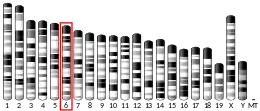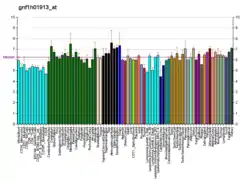Plexin-A4 is a protein that in humans is encoded by the PLXNA4 gene.[5]
Function
Plexin A4 binds to neuropilin 1 (Nrp1) and neuropilin 2 (Nrp2) and transduces signals from Sema3A, Sema6A, and Sema6B.[6] These Nrp-plexin and semaphorin complexes initiate cascades that regulate diverse processes such as axon pruning and repulsion, dendritic attraction and branching, regulation of cell migration, vascular remodeling, and growth cone collapse.[7][8] Both upregulation and downregulation of Plexin A4 has been observed following neural injury suggesting a dynamic role for Sema3A and Plexin A4 in neural maintenance and regeneration.[7][9] Additionally, Sema3A and therefore its receptor, Plexin A4, have been implicated as possible components of fast-fatigable muscle fiber denervation in ALS.[10]
Structure
Plexin A4 has ~1890 amino acids that include a likely signal sequence, transmembrane domain, and 12 extracellular N-linked glycosylation sites. It also contains domains consistent with other class A plexins including a Sema domain, three "Met-related sequences"/cysteine clusters, three extracellular glycine-proline repeats, intracellular SP domains, and a putative intracellular tyrosine kinase phosphorylation site.[11]
Tissue distribution
In the adult rat central nervous system (CNS), plexin A4 was present in neurons and fibers throughout the brain and spinal cord, including neocortex, hippocampus, lateral hypothalamus, red nucleus, facial nucleus, and the mesencephalic trigeminal nucleus. Fibers expressed Plexin A4 in the lateral septum, nucleus accumbens, several thalamic nuclei, substantia nigra pars reticulata, zona incerta, pontine reticular formation, as well as in several cranial nerve nuclei.[12] Plexin A4 has been found in dorsal and, to a greater extent, ventral horns of the spinal cord. Both motor neurons and interneurons in the ventral horn express Plexin A4. Motor axons exiting via the ventral roots and the ascending and descending white matter tracts express Plexin A4. In dorsal root ganglia, Plexin A4 is expressed in the neuronal cell bodies as well as the central and peripheral processes of those cells.[7]
References
- 1 2 3 GRCh38: Ensembl release 89: ENSG00000221866 - Ensembl, May 2017
- 1 2 3 GRCm38: Ensembl release 89: ENSMUSG00000029765 - Ensembl, May 2017
- ↑ "Human PubMed Reference:". National Center for Biotechnology Information, U.S. National Library of Medicine.
- ↑ "Mouse PubMed Reference:". National Center for Biotechnology Information, U.S. National Library of Medicine.
- ↑ Tamagnone L, Artigiani S, Chen H, He Z, Ming GI, Song H, Chedotal A, Winberg ML, Goodman CS, Poo M, Tessier-Lavigne M, Comoglio PM (October 1999). "Plexins are a large family of receptors for transmembrane, secreted, and GPI-anchored semaphorins in vertebrates". Cell. 99 (1): 71–80. doi:10.1016/S0092-8674(00)80063-X. PMID 10520995. S2CID 17386412.
- ↑ Suto F, Ito K, Uemura M, Shimizu M, Shinkawa Y, Sanbo M, Shinoda T, Tsuboi M, Takashima S, Yagi T, Fujisawa H (April 2005). "Plexin-a4 mediates axon-repulsive activities of both secreted and transmembrane semaphorins and plays roles in nerve fiber guidance". J. Neurosci. 25 (14): 3628–37. doi:10.1523/JNEUROSCI.4480-04.2005. PMC 6725384. PMID 15814794.
- 1 2 3 Gutekunst CA, Stewart EN, Franz CK, English AW, Gross RE (May 2012). "PlexinA4 distribution in the adult rat spinal cord and dorsal root ganglia". J. Chem. Neuroanat. 44 (1): 1–13. doi:10.1016/j.jchemneu.2012.03.002. PMC 3367504. PMID 22465808.
- ↑ Bussolino F, Valdembri D, Caccavari F, Serini G (2006). "Semaphoring vascular morphogenesis". Endothelium. 13 (2): 81–91. doi:10.1080/10623320600698003. PMID 16728327.
- ↑ Spinelli ED, McPhail LT, Oschipok LW, Teh J, Tetzlaff W (February 2007). "Class A plexin expression in axotomized rubrospinal and facial motoneurons". Neuroscience. 144 (4): 1266–77. doi:10.1016/j.neuroscience.2006.10.057. PMID 17197097. S2CID 30980461.
- ↑ De Winter F, Vo T, Stam FJ, Wisman LA, Bär PR, Niclou SP, van Muiswinkel FL, Verhaagen J (2006). "The expression of the chemorepellent Semaphorin 3A is selectively induced in terminal Schwann cells of a subset of neuromuscular synapses that display limited anatomical plasticity and enhanced vulnerability in motor neuron disease". Mol. Cell. Neurosci. 32 (1–2): 102–17. doi:10.1016/j.mcn.2006.03.002. PMID 16677822. S2CID 466902.
- ↑ Suto F, Murakami Y, Nakamura F, Goshima Y, Fujisawa H (March 2003). "Identification and characterization of a novel mouse plexin, plexin-A4". Mech. Dev. 120 (3): 385–96. doi:10.1016/S0925-4773(02)00421-5. PMID 12591607. S2CID 12411422.
- ↑ Gutekunst CA, Stewart EN, Gross RE (2010). "Immunohistochemical Distribution of PlexinA4 in the Adult Rat Central Nervous System". Front Neuroanat. 4. doi:10.3389/fnana.2010.00025. PMC 2914526. PMID 20700382.





